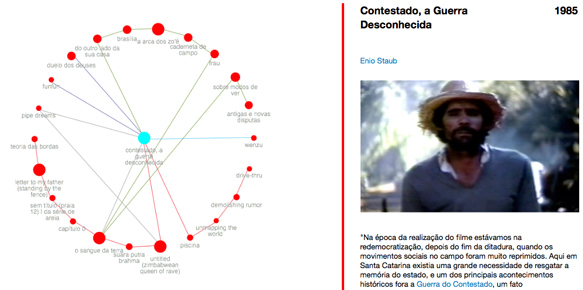Enio Staub
Enio Staub is a film and television director and scriptwriter. His productions feature strong political overtones and include the medium-length film Cone Sul (1983), about political exiles and Operation Condor, and made during the military dictatorship in Brazil. He also directed Movimento (1987), the first Brazilian TV series to document popular organizations in the country.
The documentary Contestado, a Guerra Desconhecida (Contestado, the Unknown War, 1985) was made during the re-democratization of Brazil. The period saw the formation, in countryside Paraná State, of the MST (Landless Rural Workers’ Movement). As noted by curator Manuela Moscoso in a text for the Unerasable Memories exhibition book, the documentary “must be associated with this context and the political climate in Brazil at that time.”
The video rememorates the conflict that took place between 1912 and 1916 in Paraná and Santa Catarina States. The São Paulo-Rio Grande railway was built in the area by the US-based company Union Farquhar with backing from Brazilian colonels and government. The undertaking required the hiring of thousands of workers and repossession of land. Once construction was completed, the large contingent of unemployed workers and dislodged peasants sparked the popular uprising that led to the Contestado War. One of the major Brazilian revolts, Contestado was regarded as the new Canudos and, akin to the latter campaign in Bahia, also had its own mystical monger – messianic leader and monk José Maria. As the movement grew more organized, Exército Encantado de São Sebastião (the Enchanted Army of Saint Sebastian) was formed. The number of rebels, Staub’s film reports, was as high as 20,000. The Brazilian Army made several incursions before capturing the last leader standing, Adeodato. Repression against the Contestado War was the modern Brazilian Army’s first major trial-by-fire. It was also the first time military aviation played an active role in South America. According to estimates, over 20,000 people – or one third of the Santa Catarina State’s population – died in combat.
The film revisits archival photographs and films commissioned by Union Farquhar. Research was primarily based on oral sources. Enio Staub has told PLATFORM:VB that his team counted on the “longevity and fundamentally the memory of the witnesses.” Manuela Moscoso notes that this was actually a civil war, “people against people,” and the piece’s goal is to have viewers realize this fact. “Throughout the film, we hear the perspectives of all those involved: the defeated, the winners and those who would not take sides.”
Contestado, a Guerra Desconhecida – which became part of the Videobrasil Collection following the 3rd Festival (1985) – remains current in its questioning of the need for an agrarian reform. “By the time documental research was completed, the landless movement was on the rise, and the documentary’s opening scenes were filmed at the landless settlement in the Chapecó area. It was a way of showing that although it seemed historical only, the subject matter was a current issue, and so it remains,” Staub asserts.
Learn more about the artist:


